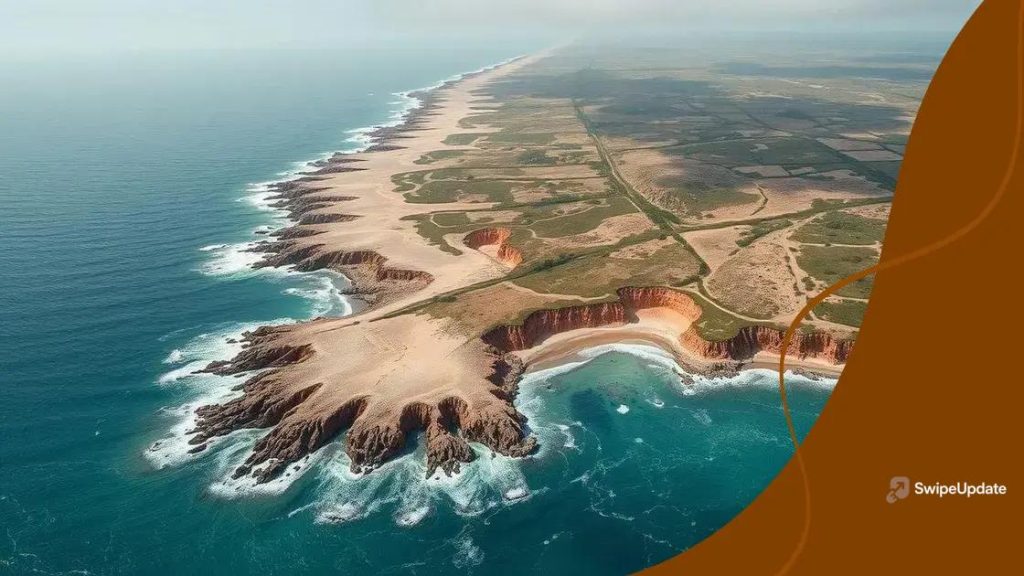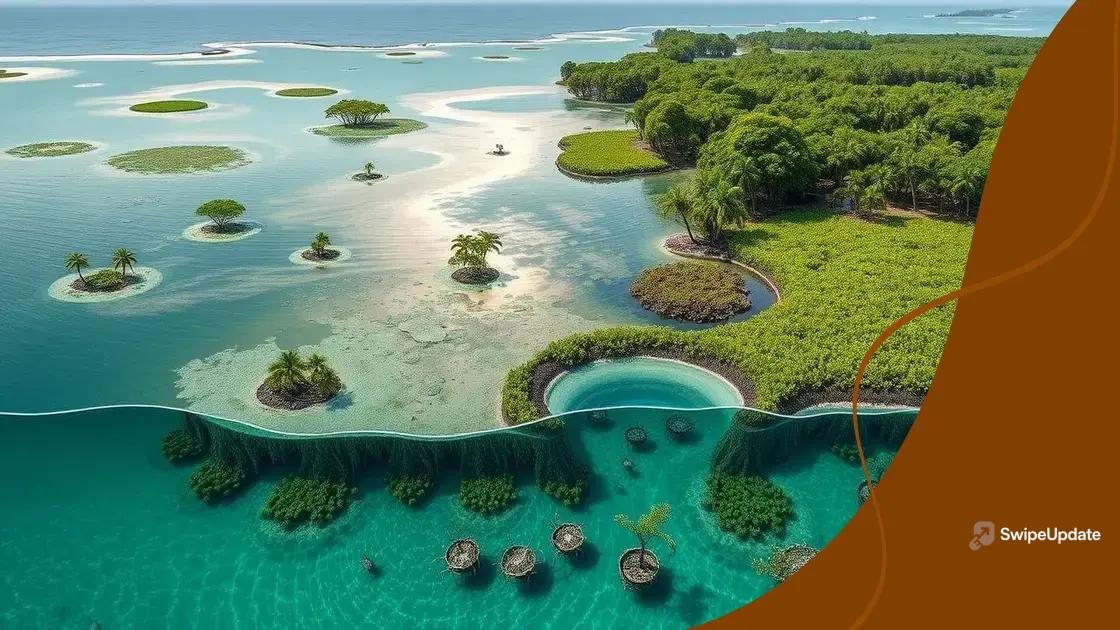How climate change is affecting coastal areas in the US

Climate change significantly affects coastal areas in the US by causing rising sea levels, increased storm intensity, ecosystem disruptions, and economic challenges for local communities.
How climate change is affecting coastal areas in the US is a pressing issue as we witness shifting weather patterns and rising sea levels. Have you considered how this phenomenon impacts your local coastline?
Rising sea levels and their impact
Rising sea levels are a significant consequence of climate change that affects coastal areas in the US. As temperatures increase, glaciers and polar ice caps are melting, leading to a gradual rise in ocean levels. This phenomenon poses serious risks not only to the environment but also to human communities.
Causes of Rising Sea Levels
There are two main causes of rising sea levels: thermal expansion and glacial melt. When ocean water warms, it expands. Additionally, melting glaciers contribute significant amounts of freshwater to the seas.
Impacts on Coastal Areas
Coastal regions face various challenges due to rising sea levels. Here are some crucial impacts:
- Increased flooding during storm surges.
- Loss of habitat for plants and animals.
- Saltwater intrusion into freshwater supplies.
- Higher risks of erosion along shorelines.
As coastal areas become more vulnerable, communities are looking for ways to adapt to these changes. For instance, some are investing in seawalls and other protective structures to guard against flooding. Others are implementing natural solutions, like restoring wetlands that can absorb excess water.
Moreover, it’s essential for local governments to plan strategically for future risks associated with rising sea levels. This includes revising zoning laws and developing infrastructure that can withstand higher water levels. Collaboration among residents, scientists, and policymakers is crucial to successfully address these challenges.
Increased storm intensity and frequency
The frequency and intensity of storms have greatly increased due to climate change. This rise in extreme weather events can have devastating effects on coastal areas in the US. As temperatures rise, the atmosphere holds more moisture, leading to stronger storms that can bring heavier rain and more violent winds.
Effects of Increased Storm Intensity
Increased storm intensity leads to a range of challenges for coastal communities. Higher wind speeds can cause extensive damage to buildings and infrastructure, while intense rainfall can lead to flooding.
The Role of Climate Change
Climate change significantly affects storm patterns. Warmer ocean waters provide energy that fuels storm formation. As a result, we can expect more powerful hurricanes and tropical storms. When these storms make landfall, the impact is often catastrophic.
- Storm surges can inundate low-lying areas.
- Infrastructure damages can lead to costly repairs.
- Displacement of communities is becoming more common.
- Emergency response systems are often overwhelmed.
Communities in affected areas are adapting by improving their preparedness plans. They are strengthening buildings to withstand higher wind speeds and investing in better drainage systems to handle increased rainfall. It’s essential for local leaders and residents to collaborate on measures that reduce risks and increase resilience.
Furthermore, education and awareness play crucial roles in disaster preparedness. When communities know what to expect and how to respond, they can minimize the impact of these intense storms. Engaging in community drills and sharing information about evacuation plans can make a big difference.
Ecosystem changes in coastal habitats

Coastal habitats are facing significant changes due to climate change, especially with rising sea levels and increased storm activity. These ecosystem changes affect not only the plants and animals that live there but also the people who depend on these ecosystems for their livelihoods.
Impact on Biodiversity
As sea levels rise, the habitats of various species are altered. Wetlands are increasingly submerged, which threatens the delicate balance of these ecosystems. Many species, such as fish and migratory birds, rely on these areas for breeding and feeding.
Habitat Loss and Degradation
More frequent storms lead to habitat loss and degradation. Coastal areas, like mangroves and salt marshes, play an essential role in protecting shorelines and providing breeding grounds for fish. When these habitats are damaged, it reduces biodiversity and disrupts food chains.
- Many species of fish are forced to migrate to find suitable habitats.
- Bird populations may decline due to loss of nesting sites.
- Native plants are becoming outcompeted by invasive species.
- Overall ecosystem health is compromised, affecting water quality.
Additionally, changing water temperatures can lead to shifts in species populations. Fish, for example, may move to cooler waters, which impacts fishing industries and local economies. Efforts are being made to restore and protect these vital coastal ecosystems, ensuring they can adapt to ongoing changes.
Engagement between scientists, local communities, and policymakers is essential to develop strategies for conservation. By understanding the challenges that coastal ecosystems face, we can work towards solutions that benefit both the environment and the people who depend on it.
Economic challenges for coastal communities
Coastal communities are facing numerous economic challenges due to climate change. As natural disasters become more frequent and intense, the costs associated with recovery and rebuilding are rising. This creates significant financial strain on local economies.
Impact on Local Economies
The economy of coastal areas largely depends on tourism, fishing, and other marine activities. When severe storms hit, businesses often suffer from damage and loss of income. For example, beach closures can deter tourists, leading to reduced revenue for hotels, restaurants, and local shops.
Infrastructure Costs
Repairing and upgrading infrastructure is another pressing issue. Roads, bridges, and public facilities frequently require costly renovations after damaging storms.
- The demand for flood protection systems is increasing.
- Stormwater management costs are skyrocketing.
- Insurance premiums are rising, affecting homeowners and businesses.
- Local governments may struggle to allocate funds for necessary repairs.
Moreover, job markets are impacted as fishing and tourism industries face uncertainty. Fishermen may find their catches dwindling due to ecosystem changes, while tourism may decline due to concerns over safety and environmental quality.
In addition to immediate costs, there are long-term implications. Communities may need to invest in new initiatives to promote sustainability and resilience. Local leaders must work together to implement strategies that support economic growth while tackling the challenges presented by climate change. Collaboration is key, as partnerships between governments, businesses, and nonprofit organizations can pave the way for innovative solutions.
Adaptation strategies for coastal areas
Coastal areas need effective adaptation strategies to cope with the impacts of climate change. As conditions change, communities must find ways to protect their residents, wildlife, and infrastructure. These strategies can help maintain the health of coastal ecosystems and ensure the safety of communities.
Building Resilient Infrastructure
One important adaptation strategy is to build resilient infrastructure. This involves designing structures to withstand extreme weather and rising sea levels. For instance, elevating buildings and roads can minimize damage during floods. Additionally, incorporating flood walls and levees can provide vital protection.
Restoring Natural Barriers
Another powerful method is restoring natural barriers such as wetlands and dunes. These areas help absorb storm surges and reduce flooding. Healthy ecosystems also support wildlife and enhance the overall resilience of coastal areas.
- Planting native vegetation stabilizes shorelines.
- Creating living shorelines can replace traditional seawalls.
- Wetland restoration provides habitats for fish and birds.
- Dunes act as barriers against storm impacts.
Communities can also implement early warning systems to prepare for extreme weather. By using technology to monitor conditions, residents can receive alerts about incoming storms or flooding. This allows for timely evacuations and proactive measures to safeguard lives and property.
Public awareness is essential in fostering resilience. Educating residents about risks and available resources enhances community preparedness. Collaboration with local governments, non-profit organizations, and citizens ensures that adaptation efforts are comprehensive and effective.
FAQ – Frequently Asked Questions about Climate Change and Coastal Areas
What are the main impacts of climate change on coastal areas?
Climate change leads to rising sea levels, increased storm intensity, ecosystem changes, and economic challenges for coastal communities.
How can coastal areas adapt to rising sea levels?
Coastal areas can adapt by building resilient infrastructure, restoring natural barriers like wetlands, and implementing effective emergency preparedness plans.
What role does community engagement play in climate adaptation?
Community engagement is crucial for effective adaptation strategies, as it fosters awareness, encourages participation, and helps gather local input for better decision-making.
What are some economic challenges faced by coastal communities?
Coastal communities face challenges such as loss of tourism revenue, increasing costs for infrastructure repair, and potential job losses in industries like fishing and tourism.
